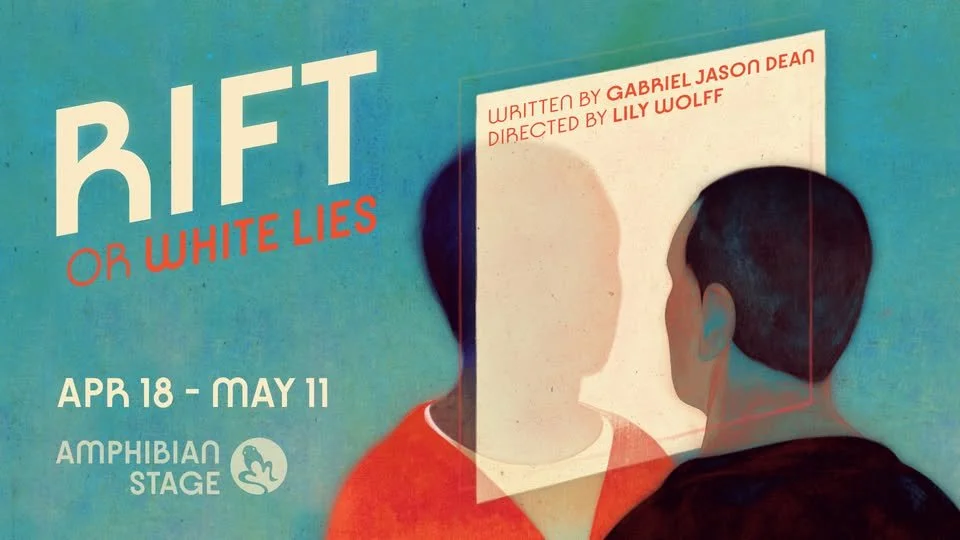‘Rift, or White Lies’ @ Amphibian Stage
Production photos by Evan Michael Woods
—Jan Farrington
take a breath bro
I ain’t no ghost
least not yet
There’s an Inside Brother, and an Outside Brother—the first in prison, the second in college. The first in prison, the second a published author. The first (still) in prison, the second a professor at Princeton. Inside Bro always needs money (and snacks), Outside wants Inside to read the “improving” books he brings him.
Half-brothers they are, to be clear—bound by a dire childhood, and moving through their lives on two wildly, painfully different American trajectories. They meet across prison barriers, trying to get things straight, trying to reach one another for their own reasons and needs. And though they say it isn’t so, they are “ghosts” in one another’s lives, hauntingly present in every moment.
Amphibian Stage’s production of Gabriel Jason Dean’s Rift, or White Lies—directed with held-in-check ferocity by Lily Wolff—has an intensity that works on the macro and micro level. Part of a rolling world premiere from the National New Play Network, it’s a story of two brothers and an exploration of our red-hot national divide—without becoming preachy or letting its brothers diminish into “stand-ins” for a single view.
Set designer Leah Mazur’s stark and intriguing stage design telegraphs what’s going on: a raised oblong space puts Inside Brother at one end, and Outside Brother at the opposite, divided by two edges they seldom cross. (Each, literally, have a “platform” to stand on.) Below and around the stage is a rimmed channel filled with leaves and remnants of their lives, from bikes and skateboards to footballs and empties of beer and whiskey.
The two very watchable actors onstage, Jonathan R. Freeman and Taylor Harris, switch between the roles in a regular rotation. (Amphibian’s website will tell you who’s who on any given night of the run.) I plan to see it again with the actors reversed. What might a different physical presence and manner in each role change about my response to the play? I would guess it still will be tough to watch at times, and vividly profane and funny at others, in the way sharp pain has of turning into edgy humor.
Dean has a gift for dialogue, and uses the autobiographical aspects of the story with heart and intelligence—and a full awareness of the complications. No one, not even a playwright, can make a tidy sound bite out of the current American dilemma: “They” are blaming the wrong people (Blacks, immigrants, et al.) for their tough, limited lives—but at the same time, “they” aren’t wrong about the raw deal the U.S. has given generations of working- and lower-class Americans. Can we talk?
The brothers meet sporadically, and sometimes many years pass between encounters. Freeman (Inside Brother at the performance I saw) gives his character the honed anger of the prisoner, mocking his brother’s mild complaints about life: “Can’t be easy for you,” he says—”freedom/ choices/ legs that work/ girls/ that’s gotta be sooo hard for you….
He prowls like a cat, darting forward to deliver a sharp line, retreating as he watches it land. We’d guess his default setting is Extremely Angry, but there’s a warmth to him as he teases Outside “little bro” (Taylor Harris) about his girlfriend: “Oh, that’s a smitten face right there….” Both agree they’d like to talk—to get “real real” with each other as they did as boys.
Harris plays Outside Bro as more awkward, less charismatic, but with an endearing hesitancy mixed with a strong will to succeed—even if he makes things hard by using their abusive family history as material for his writing. The brothers agree on some basics about American life: for one, that society works to keep poor people poor. “They all killing us,” says Inside Brother, remembering older family members “working like machines they whole lives.” (He’s adopted the Southern/Black cadences he hears around him in the prison population.)
Outside Bro has absorbed the writings of James Baldwin and Ta-Nehisi Coates into his thinking about the sort of white supremacy tenets his brother now holds. To put it super simply: If white people could achieve better lives, be less obsessed about “who’s on top,” would there be less reason for racism? The bro’s quirky, sideways arguments about that are fascinating, even as we laugh a bit at their lurches toward wisdom. “The Outside’s getting more like the Inside every day,” is a line that’s still rolling around in my head.
A beautiful effect toward the end of the play (an integral element of Mazur’s set design, executed by technical director Jeff Stanfield) seems to clear and cool the atmosphere, and a circling, dream-like exchange closes the circle, or perhaps opens it up to begin again: He could have been me; I could have been him. We can understand each other…can’t we?
David Lanza’s infusions of sound and music (indie-meets-bluegrass?) music choices and enrich the action onstage, as do Adam Chamberlin’s lights, whether shadowy or dazzlingly in-your-face. And though Katelyn Jackson’s costumes seem simple (jumpsuit, tees, cargo shorts, professor togs), I loved the color match for the brothers in the last scene, with prison orange jumpsuit echoed by an orange college tee.
There’s limited seating for Rift (about 50 seats per show; the impressive set takes up most of the theater), so the time to snag a ticket is now….
WHEN: April 18-May 11, 2025
WHERE: 120 South Main St., Fort Worth
WEB: amphibianstage.com







